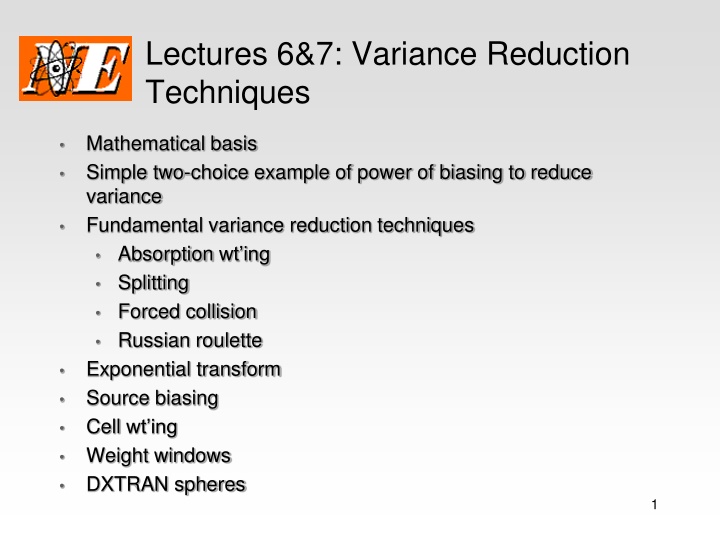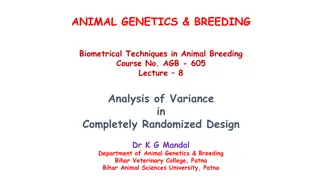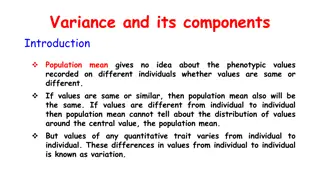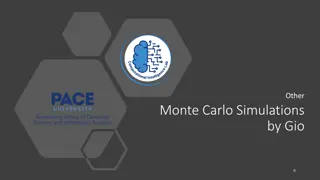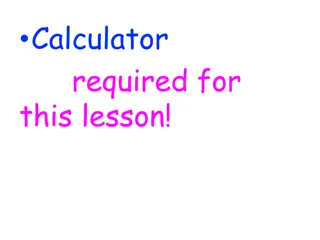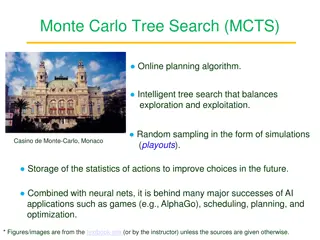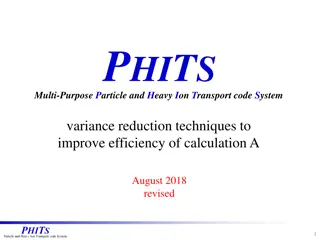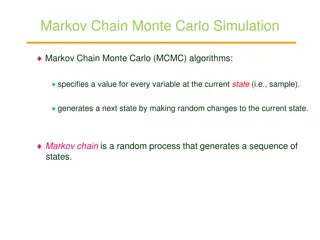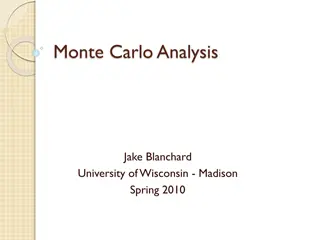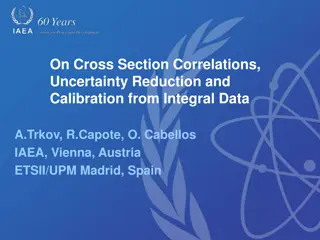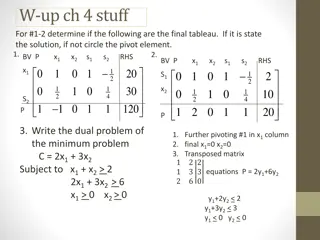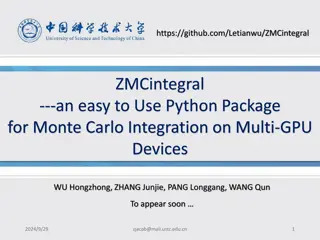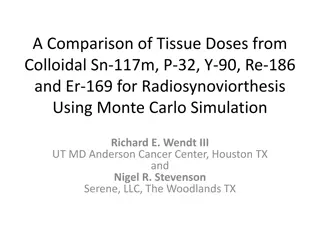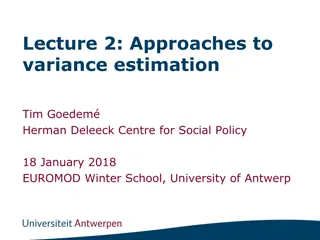Variance Reduction Techniques in Monte Carlo Programs
Understanding variance reduction techniques in Monte Carlo simulations is essential for improving program efficiency. Techniques like biasing, absorption weighting, splitting, and forced collision help reduce variance and enhance simulation accuracy. By adjusting particle weights and distributions, programs can produce more consistent results with lower variance. Examples illustrate how biasing probabilities can optimize simulation outcomes in different scenarios.
Download Presentation

Please find below an Image/Link to download the presentation.
The content on the website is provided AS IS for your information and personal use only. It may not be sold, licensed, or shared on other websites without obtaining consent from the author.If you encounter any issues during the download, it is possible that the publisher has removed the file from their server.
You are allowed to download the files provided on this website for personal or commercial use, subject to the condition that they are used lawfully. All files are the property of their respective owners.
The content on the website is provided AS IS for your information and personal use only. It may not be sold, licensed, or shared on other websites without obtaining consent from the author.
E N D
Presentation Transcript
Lectures 6&7: Variance Reduction Techniques Mathematical basis Simple two-choice example of power of biasing to reduce variance Fundamental variance reduction techniques Absorption wt ing Splitting Forced collision Russian roulette Exponential transform Source biasing Cell wt ing Weight windows DXTRAN spheres 1
Rules of Biasing Choosing from a probability distribution that WE want to use rather than natural Particle weight = Parts of particles Basis: If natural is , but we want to use we have to apply a weight correction of: ( ) ( ) x p ( ) x p~ ( ) x p p ~ x = wcorr (In general) All possible x's in the original distribution are still possible in the new distribution. 2
Example: Using Flat Distributions It is entirely unbiased (i.e., okay) for you to choose an x uniformly and adjust the weight contribution weight by multiplying the previous weight by the correction: ( ) ( ) ( b a ( ) 1 x x x ( )( x b a ) = = = w corr ) Unfortunately, although it is unbiased to do this, it is also usually unwise. 3
Why Do It? We do it to make our Monte Carlo programs better. "Better" means "lower variance." Lower variance, in view of our "black box" view of Monte Carlo: means "have the x's come out as nearly identical as possible." 4
Simple Example As the simplest possible example, find the optimum biasing probabilities for the following 2-choice situation: i I I Error Error2 i wcorr used 1 .2 6 2 .8 1 5
Our slab example As the simplest possible example, find the optimum biasing probabilities for the following 2-choice situation (Choice of original group): i I I Error Error2 wcorr used i 1 .4 0.000734 ( =0.027) 0.000026 ( =0.005) 2 .6 6
Common Variance Reduction Techniques Non-physical distributions that have been proven useful For each of them, we will use same pattern: General description ("heuristics") of what the idea is. Which of the transport decisions is being adjusted and what the physical distribution is. Particle initial position Particle initial direction Particle initial energy Distance to next collision. Type of collision Outcome of a scattering event Non-physical distribution that we will use. Resulting weight correction. 1. 2. 1. 2. 3. 4. 5. 6. 3. 4. 7
Absorption Weighting Weighting in lieu of absorption This is the most commonly used variance reduction technique. In fact, in many transport codes, this option cannot be turned off. General description: The basis idea is to PREVENT particles from absorbing. Then particles will live longer and have more of a chance to score. Which of the transport decisions is being adjusted? #5. Type of collision. 8
Absorption Weighting (2) Mathematical layout: Assume the two possible outcomes are scattering and absorption. The natural p.d.f.'s are: Scattering with probability Absorbing with probability Our decision is to pick scattering with a 100% probability. Resulting weight correction: ( ) ( ) 1.00 x = = s 1 t a 2 t s x = = = t w s 9 corr t
Absorption Weighting (3) Note that we have made a POSSIBLE choice (absorption) IMPOSSIBLE. This is allowed ONLY because absorbed particles have NO possibility of contributing to the answer. In addition to a lower variance (per history), we are ALSO guaranteed to have higher computer run times, since each history will be longer. May or may not be worth it. Another way of looking at this: Divide particle into two parts: the fraction that scatters and the fraction that absorbs. We continue to follow only the first (scattering) and let the fraction that absorbs die. 10
Splitting Forms the basis for other variance reduction techniques. Does not really fit the pattern of MODIFYING the probability distribution. Instead, the single particle becomes multiple particles 11
Splitting (2) Two common situations in particle transport that involve splitting: Particles emitted from a collision, one of them is followed as a continuation of the current particle history, and then, after the original particle history is over, we come back and "pick up" the second particle from the original collision site and follow IT to conclusion. Particle is split into two or more "pieces" when an "important" region is entered in order to even out the statistics. Basic mathematical idea of splitting is that ALL of the options of a discrete probability distribution are followed with weight corrections proportional to the discrete probabilities. 12
Splitting (3) Example: Assume that a history (in progress) with weight of 0.5 faces a discrete decision with three possible outcomes: State 1 with a 60% probability; State 2 with a 30% probability; and State 3 with a 10% probability. Instead of choosing between the three, we follow each of them in turn. Continue the history by following the history into State 1 with a weight of 0.30 and "bank" (i.e., save in a special file of "states" to be continued later) one history in State 2 with weight 0.15 (=30% of 0.5) and one history in State 3 with weight 0.05. After a particle history ends, we return to banked particles until the bank is empty. 13
Forced Collisions General description: FORCE a collision in a particular section of the path of a particle. We will use it in a particular way, not allowing particle to escape. Keeps particles alive longer, so should increase contribution to all scores Which of the transport decisions is being adjusted: #4. Distance to next collision. 14
Forced Collisions (2) Mathematical layout: This is a splitting technique: the particle is divided between the part that DOES collide in the desired region and the part the DOES NOT collide in the desired region. Assume the distance to the boundary is t0 (in mean free paths) Actual probability distribution: Probability of escaping: Non-escape with probability: Our decision non-escape with probability 1.00. escape = = e 0 non escape 1 e 0 15
Forced Collisions (3) Weight correction: ( ) ( ) x x 1 e 0 = = = i 1 w e 0 corr 1 i Remember the splitting "roots" of this procedure, and recognize that the "other " part of the particle DOES escape. Therefore, we should contribute to the leakage of the closest boundary, where w is the weight BEFORE the correction. Again, possible that longer computer run time will hurt more than lower variance will help. In fact, most of the literature indicates that this is USUALLY that case, so that "non-escape" forced collision is seldom used. 0 we 16
Russian Roulette Like splitting, mathematical tool that is needed for implementing variance reduction techniques. Idea: COMBINE several particles into one particle by selective killing. Mathematics: Have a particle DIE with a high probability of 1-p (typically 90-99%). To keep the method unbiased, if a particle survives, its weight is increased by a factor of 1/p. 17
Russian Roulette (2) Need for this tool is obvious when used in combination with absorption weighting and forced collision--the latter two methods eliminate BOTH ways of ending a history. Without the (artificial) death condition added by Russian Roulette, the first history would never end! In practice, Russian Roulette is performed whenever a particle's weight falls below a lower weight cutoff, Although not formally reducing the variance, it increases the efficiency of a Monte Carlo process by saving the computer time that would otherwise be wasted following low weight particles. w low 18
Exponential Transform General description: The basis idea of the exponential transform technique is to make it EASIER for a particle to travel in a desired direction by THINNING the material in the desired direction and making the material DENSER in directions away from the desired direction. Does NOT make it more LIKELY that desired directions will be chosen, just easier to travel in desired directions. Which of the transport decisions is being adjusted? #4. Distance to next collision. 19
Exponential Transform (2) Mathematical layout: Change the total cross section and make it dependent on the direction traveled. Denoting the cross section used with an asterisk, we have: ( ) t t = 1 ( ) * p d where p is a general parameter chosen by the user (or programmer) with 0<p<1 and is the desired direction. Because of the limitations on p (0<p<1) these minimum and maximum values range from 0 to twice the true cross section. d 20
Exponential Transform (3) The exponential transform just involves modifying the cross sections used in translating mean free paths to centimeters. Two cases that have to be considered: The particle reaches the outer boundary or it collides inside the problem geometry. Actual probability distribution: Probability of escaping: escape = e 0 Probability of next collision at distance s: ( ) = ts s e 21 t
Exponential Transform (4) For each of these two conditions, the probability distributions actually used are: Probability of escaping: Probability of next collision at distance s: ( ) s ( ) 1 p escape = e 0 d ( ) ( ) 1 p s = 1 p e t d t d Resulting weight correction: If the particle escaped: e 0 = = p w e 0 d ( ) corr 1 p e 0 d If the particle collided at distance s: p e e 0 0 d = = ( 1 ) t w ( 1 ) ( ) corr 1 p p p e 0 d d t d 22
Source Biasing General Description: The most general of the variance reduction techniques. The basic idea is simple: Instead of using the true distribution, use some other distribution, i.e., that you have some reason to believe is better. Which of the transport decisions is being adjusted? #1-#3. Initial source position, energy, and direction. 23
Source Biasing (2) Mathematical layout and weight correction: In the basic layout of the idea, no guidance is actually given about distributions to use. Therefore, all we have is the basic theory laid out above in the "Mathematical basis of cheating" section: "So, if the probability distribution dictated by the physics is and we want to use a second distribution , we can do it if we use a weight correction, ( ) ( ) x ( ) x ( ) x x = w 24 corr
Choosing Modified Distribution In general, you want to modify the natural distributions in order to favor choices that are more IMPORTANT. What is "importance"? To us the answer is simple: IMPORTANCE = EXPECTED CONTRIBUTION Therefore, our job is to modify the distributions to favor following the particles that are the expected to contribute the most to the "score . 25
Choosing Modified Distribution (2) How much should we favor these choices? If you know the importance of each of your possible choices, I(x), the theoretically optimum choice of your alternate distribution is given by: ( ) ( ) ( ) ~ x x I x The successful approaches I have seen to picking alternate distributions fall into the following three categories: Heuristic (i.e., seat of the pants) choices, Choices based on preliminary MC calculations, and Choices based on preliminary non-MC calculations. 26
Category 1: Heuristic Modify the natural distribution to favor the choice of particles that you think MUST BE more important. EXAMPLE 1: Source particle location (Decision #1) If you are interested in determining the right leakage, pick source locations preferentially to the right EXAMPLE 2: Source direction (Decision #2) If you are interested in determining the left leakage, pick source directions preferentially heading to the left. EXAMPLE 3: Source energy (Decision #3) If you are interested in deep penetration, pick source energies where total cross section is low. You are left to your own intuition about HOW MUCH to favor the more important particles. Therefore, this approach is trial and error. 27
Category 2: Preliminary MC Calculations This technique is based on you running a few (hopefully) short "test runs" to get the relative importance of various initial source choices. The test cases correspond to restricting the choices of one of the variables to a sub-domain, running a short problem, and interpreting the resulting answer as the importance of the sub-domain and using: ( ) ( ) ( ) ~ x x I x There is an automatic Weight Windows Generator in MCNP that does this for you: Generates data during ONE run to collect data to speed up the NEXT run. We will be using this tool in a later tutorial 28
Category 3: Preliminary Non-MC Calculations As we will study later in the course, we can actually write and solve an equation for the importance function for source particle (and scattered particle) distributions. This equation can be approximately solved using deterministic methods (e.g., discrete ordinates) for the importance function, which can then be used in the MC calc We will postpone this state-of-the-art topic to explore in more detail later 29
Cell Weighting in MCNP (And Beyond) Rules: When you pass from region of lower weight to higher weight, split by ratio I newI old When you pass from HIGHER to LOWER, play Russian Roulette with survival probability of newI I 30 old
Weight Windows in MCNP Rules: When you pass from OLD to NEW, adjust weight to stay in a desired window of weights for each cell: Use RR and splitting as before, utilizing w w w w low desired high 31 currentw desired
Importance Mesh Grids Latest variance reduction technique in MCNP Overlay the REAL problem geometry with a regular Cartesian grid of cells with importance function given Regularizes the spatial density of importance function Importance functions can be found from a deterministic calculation Corresponding mesh tallies available as well (in MCNP) 32
DXTRAN Spheres MCNP-specific VR method Put a sphere in the problem somewhere and split EACH emerging particle (including source) into 2 parts: a part that passes through the sphere and a part that doesn t Typical splitting strategy with one exception: Very difficult to determine the theoretical weight of each particle (which is based on the total probability of hitting the sphere) 33
DXTRAN Spheres (2) Clever solution to problem: Stochastically determine the probability: Choose ONE direction that is headed toward the sphere (with weight correction) Translate the DXTRAN particle to the surface of the sphere (with weight correction) Make NO correction to the weight of the OTHER particle (that does not go directly to the sphere) BUT kill the particle if it touches the sphere on the next flight 34
FOM Figure of Merit (FOM) is a method of comparing MC runs for efficiency: 1 ??? = (??? ????)(???????? ?? ???) Based on: ( ) x N 2 ( ) 2 N = x and the assumption that N~T, the FOM should be approximately constant. 35
FOM (2) Printed out by MCNP in a table at the end (at ~10 times during the run), it can be used several ways: 1. To compare different computer systems 2. To check the efficiency gains (?) from a variance reduction technique 3. To check that the problem is proceeding smoothly 36
FOM (3) FOM table (on one tally only) and finish tally 11 nps mean error vov slope fom 1000 1.5133E-02 0.2017 0.0564 0.0 788 2000 1.3912E-02 0.1496 0.0311 0.0 723 3000 1.4250E-02 0.1187 0.0198 0.0 773 4000 1.4203E-02 0.1044 0.0154 0.0 747 5000 1.5107E-02 0.0911 0.0114 0.0 788 6000 1.3896E-02 0.0860 0.0103 0.0 740 7000 1.4112E-02 0.0787 0.0087 0.0 758 8000 1.4461E-02 0.0726 0.0073 0.0 778 8546 1.4406E-02 0.0701 0.0068 0.0 780 *************************************************************************************** ******************************** dump no. 2 on file tut1r nps = 8546 coll = 1106205 ctm = 0.26 nrn = 15526679 3 warning messages so far. run terminated when it had used 0.2 minutes of computer time. computer time = 0.36 minutes 37
